by Ellen Wolter
Minnesota Compass staff have been on the road across Minnesota to hear from communities about the information and tools they need to better understand the opportunities and challenges facing their regions. Here are a few highlights of demographic and economic trends in greater Minnesota, and how we are working with communities to improve the information and tools that we provide for regions across the state .
Central Region
The Central region has seen the largest growth in jobs among all regions in Minnesota. The region's growing economy continues to attract residents and population should continue to grow in coming years.
Not all areas of the region have benefited from economic growth, however. Brainerd, for example, has the highest poverty rate and the lowest proportion of adults working among major cities in the state.
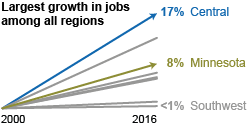
Northland Region
The Northland region residents face economic challenges, including a higher poverty rate and lower median household income than many other regions of the state. The Northland region also faces a growing older adult population and changing economy, particularly on the Iron Range. The Northland region's share of jobs in the education and health industry sector is now tied with the Southern region, a region traditionally defined by its affiliation with health care. The second largest industry in the Northland region is leisure, a notable difference from other greater Minnesota regions, where manufacturing is among the top industries.
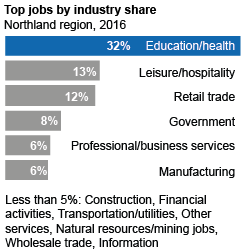
Northwest Region
The Northwest region's economy lags behind other Minnesota regions, with stagnant job growth over the last two years and one of the highest poverty rates and lowest median household incomes among regions across the state. There are pockets of job growth in some communities in the Northwest region, but housing and transportation expenses as a share of household income are among the highest in the state.
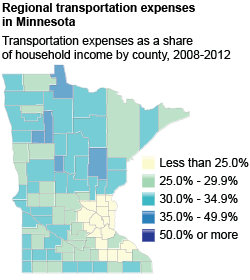
Southern Region
Minnesota's Southern region is home to growing older adult and foreign-born populations. Today, at least one in ten residents of Rochester, Faribault, and Austin is foreign born. The region's two largest industries – education/health and manufacturing – may be a draw for residents seeking employment opportunities. As the home of the Mayo Clinic, the Southern region has long been affiliated with high-quality health care. One in three jobs in the region are in the education/health industry. But the region is also home to a strong and steady manufacturing sector, the second largest employer by industry in the region.
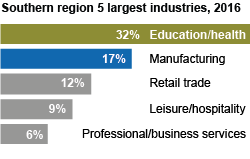
Southwest Region
The Southwest region is in the midst of demographic changes by age and nativity. The region is home to a declining working-age population. Some communities have seen an influx of foreign-born residents in recent years, likely drawn to job openings and economic opportunity. Worthington, for example, has the largest concentration of foreign-born residents in the state at 30 percent.
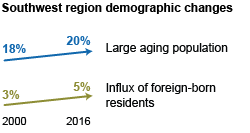
West Central Region
Overall, the West Central region's economy is growing, with an increasing number of jobs, high proportions of adults working and poverty rates on par with Minnesota. However, areas of this region are faced with large older adult populations in or approaching retirement. For example, Fergus Falls ranks 3rd and Alexandria ranks 6th (now 1st and 5th, as of 2020) among major Minnesota cities for the share of residents age 65+, and both have among the highest retirement- to working-age ratios in the state. A growing economy and a declining working-age population are among the factors contributing to potential workforce shortages in this region in coming years. Availability and affordability of childcare, housing, and transportation also play key roles in attracting and retaining workers.
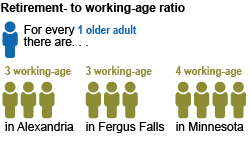
Telling greater Minnesota's story
Minnesota Compass provides valuable data for regions, counties, and cities across Minnesota. Minnesota's school boards, city and county planners, community health boards, non-profits, social service agencies, health care organizations, community organizations and foundations use Minnesota Compass to guide their work.
The Initiative Foundation uses the Minnesota Compass website nearly constantly! The ease with which one can review historic trends and projected future outcomes, sort by geography or targeted population, and compare a community or county of interest to an appropriate peer benchmark is invaluable in helping us set strategic priorities, develop grant proposals, and remain responsive to the emerging needs of our region. –Don Hickman, Vice President of Community and Workforce Development, Initiative Foundation
We want to improve the information and tools we provide for greater Minnesota to help identify, understand, and act on issues that affect their communities. As part of that effort, Minnesota Compass has been holding listening sessions across the state to gather feedback about key regional issues and the information needed to address them, and how to make the data tools easier to use. Listening sessions are being held in:
- Southern: Rochester & Austin
- Central: St. Cloud & Brainerd
- Northland: Hibbing & Grand Rapids
- Northwest: Bemidji & Crookston
- West Central: Fergus Falls & Alexandria
- Southwest: Worthington, Willmar, & Redwood Falls
- Twin Cities
The listening sessions will conclude in October. Our goal is to use what we've learned to inform improvements to Minnesota Compass in 2018.
"Accurate facts from a reliable, independent source are crucial in a democracy. Minnesota Compass offers pragmatic, updated data for community members, policymakers, businesses, and foundations like McKnight to truly step back and get a big-picture sense of emerging needs and trends, which in turn helps us all better prepare for the future. Continuing to listen to communities about the information and tools they need helps Minnesota Compass provide relevant and useful data." –Sarah Hernandez, McKnight Foundation
To learn more about the Minnesota Compass listening sessions, contact Ellen Wolter at ellen.wolter@wilder.org